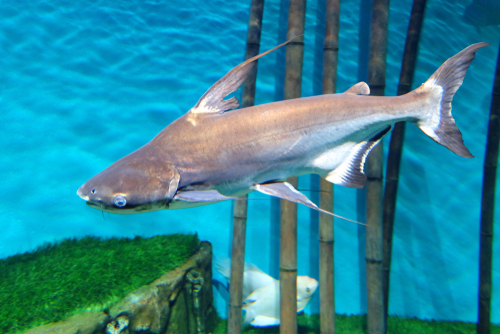Sharks are known as the big, bad predators of the sea, though they don’t actually cause as much death as some think. These magnificent, larger-than-life fish are by all means fascinating, as are the 15+ popular fish that look like sharks.
Some of the popular fish that look like sharks are even called sharks, despite not actually belonging to the shark species of fish. While they mimic the shark in size or by their signature dorsal fin, these fish are incredibly unique in their own right despite their similar appearance.
Some of these fish are actually small enough and docile enough to keep in your home aquarium. Below is a snapshot of the most popular fish resembling sharks in many ways.
- Bowmouth Guitarfish
- Sawfish
- Iridescent Shark
- Columbian Shark
- Bicolor Shark
- Bala Shark
- Mekong Giant Catfish
- Chinese High Fin Banded Shark
- Siamese Algae Eater
- Violet Blushing Shark
- Rainbow Shark
- Paroon Shark
- Remora
- Shark Catfish
- Roseline Torpedo Shark
- Harlequin Shark
- Black Shark Minnow
- Silver Apollo Shark
- Golden Shark
Contents
15+ Popular Fish That Look Like Sharks
Other popular posts:
- Fish With Black Stripes
- Popular Fish That Look Like Snakes
- Popular Fish That Look Like a Stingray
- Popular Fish That Look Like Dragon
1. Roseline Torpedo Shark
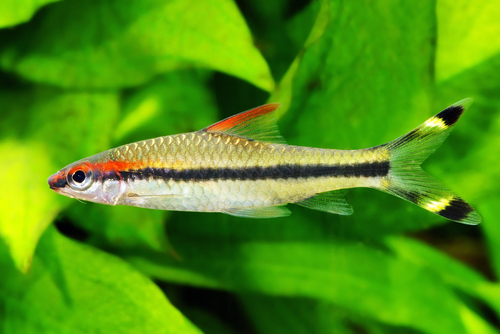
- Scientific Name: Sahyadria denisonii
- Diet: Roseline torpedo sharks are omnivores that are fairly simple to feed, and like bloodworms, vegetation, and fish flakes.
This gorgeous looking barb is native to India, but can also be suited for aquarium life. They look like sharks because of the placement of their fins and the shapes of the tail, but that’s where the equivalencies end.
A roseline torpedo shark only grows about six inches long, and they have distinct black striping with smaller red and yellow accents.
2. Bowmouth Guitarfish

- Scientific Name: Rhina ancylostoma
- Diet: The bowmouth guitarfish enjoys a diet of various crustaceans and mollusks.
The bowmouth guitarfish is a striking fish that could easily be mistaken for a shark from a short distance. Their prominent dorsal fin, long tails, and even their pectoral fins all make them appear very much like a shark.
Once you look at their flat head with their bowed mouth, it’s easy to see that this is, in fact, not a shark. Unfortunately, this astounding fish is critically endangered.
3. Sawfish
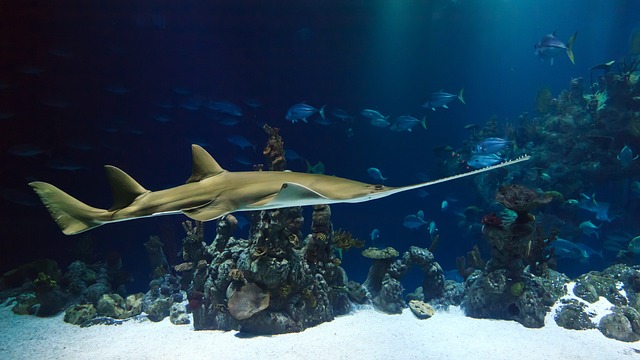
- Scientific Name: Pristidae
- Diet: The sawfish is an avid predator who eats other fish, crustaceans, and mollusks.
A sawfish could easily be misidentified as a shark if it weren’t for its incredibly long nose that features rows of sharp teeth. The rest of its body looks similar to a shark, with the dorsal fin sticking right up in the air.
This very astounding fish is sadly endangered, as it has been hunted a lot for its significance to many cultures. They look a lot like sharks because of their size, their color, and all of the same fins.
4. Iridescent Shark

- Scientific Name: Pangasianodon hypophthalmus
- Diet: These fish are omnivores, with a hearty appetite; they are known to eat other fish, various worms, plant matter, and crustaceans.
The iridescent shark gets its name for its silvery visage that shifts from light to dark. One of these fish can grow to be about four feet long, and havebfins and tails where sharks do.
While people have been known to keep iridescent sharks in aquariums, it’s not recommended as it’s not the best place for these fish to live.
5. Golden Shark

- Scientific Name: Leptobarbus hoevenii
- Diet: The golden shark is known to eat what it can find around them, which typically includes different invertebrates and vegetation.
The golden shark mimics a shark in its silhouette, with the signature dorsal fin, tail, and pectoral fins. However, this fish’s fins are almost translucent, which is very striking along with its golden hued body.
Unlike the name suggests, the golden shark is actually a barb and not a shark, and wasn’t discovered too long ago in Thailand.
6. Bicolor Shark
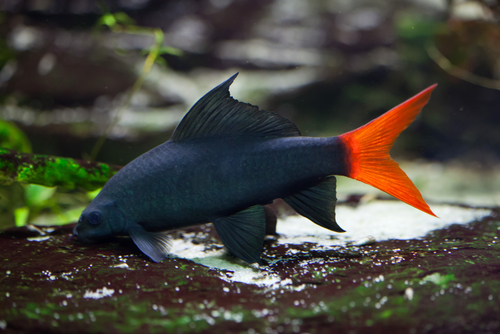
- Scientific Name: Epalzeorhynchos bicolor
- Diet: The bicolor shark is omnivorous, and likes eating a variety of plants, vegetables, small fish, bugs, and worms.
The bicolor shark gets its name for its black body and red-touched fins; those fins sit in the same spots a shark’s does. It could be said that the bicolor shark has a similar temperament to a true shark in that they can be fairly territorial when they feel they need to be.
Unlike a shark, however, this fish will typically stay six inches long and under.
7. Bala Shark
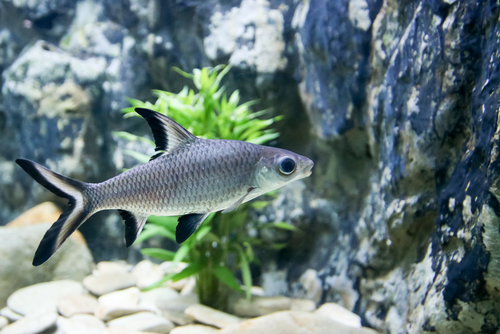
- Scientific Name: Balantiocheilos melanopterus
- Diet: Bala sharks are omnivores and enjoy snacking on vegetarian fish flakes, and in some cases, they’ve been known to eat small fish.
The bala shark almost looks like a shark that has shrunk down significantly in size, as they usually only grow to be 18 inches long at the most. They are a fairly peaceful fish with large, beady eyes, an angled dorsal fin, and small angled pectoral fins. They also have black accents that line their fins and tails, unlike sharks.
8. Mekong Giant Catfish
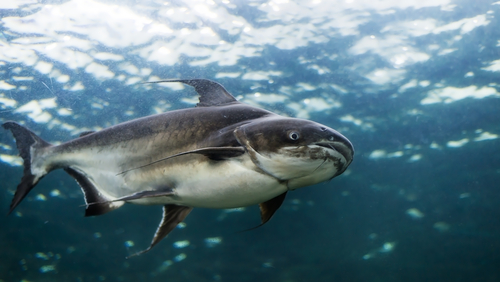
- Scientific Name: Pangasianodon gigas
- Diet: The Mekong giant catfish is an herbivore who eats zooplankton, algae, and plants. When young, they’ve also been observed eating other Mekongs.
The great Mekong giant catfish is similar to the shark both in size and in physicality, with the prominent, angular dorsal fin and the position of their eyes.
One of these phenomenal fish can reach three meters in length. They have the same coloring as a shark does for the most part, but they don’t have sharp, scary teeth like sharks do.
9. Chinese High Fin Banded Shark

- Scientific Name: Myxocyprinus asiaticus
- Diet: This particular fish has a varied diet depending on where it lives, and this includes mollusks, worms, bugs, and seaweed.
The pectoral fin on the Chinese high fin banded shark is much higher in comparison to its body than a shark’s is, but the other fins sit in the right spots.
This fish, however, is small in comparison, and has thick black stripes that run vertically on its body. Even though it’s smaller than a shark, one of these fish can grow up to four feet long.
10. Siamese Algae Eater
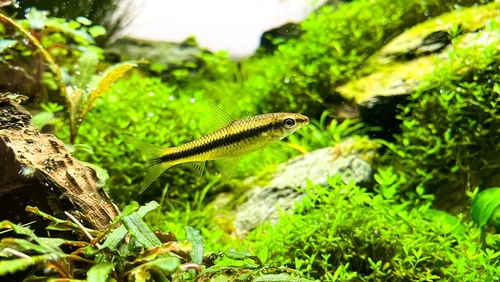
- Scientific Name: Crossocheilus oblongus
- Diet: As the name would imply, this scavenger enjoys algae, but will eat anything it can scrounge for in its environment.
The Siamese algae eater is a petite little fish that has a shape parallel to a shark with its fins and the placement of its eyes. This fish has a dark black stripe that runs along its body and translucent fins.
Depending on how they’re swimming, they seem to be almost iridescent in their coloring, shifting from gray to gold.
Many people will mistake this fish for a small version of a shark, but it doesn’t actually belong to that family of fish despite its appearance and feisty personality. They can do well in a carefully set up aquarium, and will benefit other fish in the way they help keep the aquarium clean.
11. Violet Blushing Shark
- Scientific Name: Labeo boga
- Diet: This fish is known as a bottom feeder, so they’ll pick up scraps from other fish. They’ll also eat worms, bugs, and larvae amongst other things.
The violet blushing shark gets its name from the spots of pinkish purple on its cheeks. The pink and white fish can grow up to one foot long at maturity, and as expected, have fins in similar places to a shark. Outside of this similarity, the violet blushing shark is not actually a shark.
While you can keep one of these beautiful fish at home, it’s very difficult to take care of one appropriately. As mentioned, they can grow to be pretty substantial in size, and can sometimes be mean to other fish.
12. Rainbow Shark
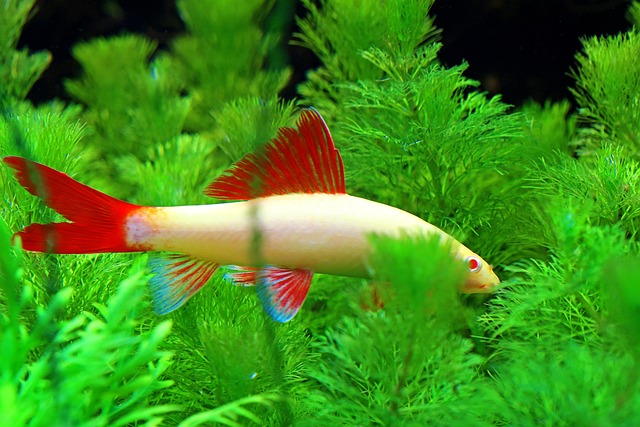
- Scientific Name: Epalzeorhynchos frenatum
- Diet: A rainbow shark can be finicky, but is known to like algae, water bugs, larvae, phytoplankton, and crustaceans.
The rainbow shark is not quite rainbow colored, but is instead dark, almost black, with bright red fins. Those fins include their dorsal fins, pectoral fins, and even their tail.
Unlike a shark, however, their fins are feathery and fanned out instead of stiff. This lovely looking fish doesn’t match a shark’s size either; they only grow to be six inches or less in length.
13. Paroon Shark
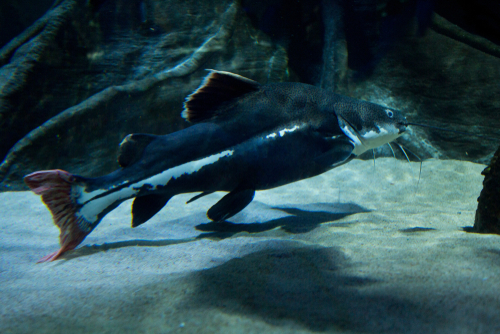
- Scientific Name: Pangasius sanitwongsei
- Diet: The paroon shark prefers substantial protein like crabs, fish, and shrimp, but will also eat plants.
A paroon shark is a dark gray fish with all the right fins in all the right places. They do look a lot like sharks, though their bodies tend to be more rotund than a typical shark.
This big fish is also known to stalk its prey in the water and are very great hunters. Despite how alike they look, the paroon shark is not a true shark.
14. Remora

- Scientific Name: Echeneidae
- Diet: Remoras are known to eat the waste of their “host fish” when they attach their bodies to a larger fish.
A remora looks incredibly similar to the shark while being much smaller than an actual shark. They do have dorsal fins, but they aren’t exactly the same in terms of their shape. Interestingly enough, these dorsal fins have a sucking ability which helps them either capture prey or defend themselves.
When they can, though, remoras prefer to use their dorsal fins to attach themselves to the bottom of a much larger fish. They will survive off of anything the large fish eats in the form of their excrement.
15. Shark Catfish
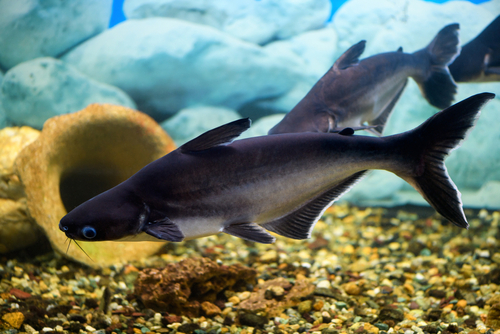
- Scientific Name: Pangasius hypophthalmus
- Diet: The shark catfish is an omnivore that prefers eating seafood, such as small fish and crustaceans.
The shark catfish is actually a family of fish that look like sharks in some ways, and also have features of a catfish. One can see this easily with its dorsal fin, though this fin is closer to their head than it usually is on a shark. Much like the catfish, a shark catfish also has whiskers, or barbels, around its cheeks.
16. Harlequin Shark
- Scientific Name: Labeo cyclorhynchus
- Diet: The harlequin shark feasts on algae, remnants of dead plants and fish, and other small organisms it can find.
A harlequin shark bears a strong resemblance to a true shark, even though it’s a very tiny fish comparatively. They tend to burrow themselves within as much shelter as they can find from surrounding plants and within cavernous areas.
Their dorsal fin is quite thin, and can be hard to see in its entirety depending on what it’s swimming near.
17. Black Shark Minnow
- Scientific Name: Labeo chrysophekadion
- Diet: The black shark minnow eats dead matter and algae, and helps keep the water it lives in very clean.
This fairly elusive fish, often called black shark, has fins that make them resemble a shark. These fins are much softer than a shark’s however, having more of a fanned texture.
You can also see the differences in their facial features, especially with the black shark minnow’s whiskers and beady eyes.
18. Silver Apollo Shark
- Scientific Name: Luciosoma setigerum
- Diet: The silver apollo shark is an omnivore, but will pick eating fish, worms, or bugs over plants and other debris in the water.
As you could guess by the name, this dish is a brilliant silver color. They also have the dorsal fin that a shark is known for, but it’s more of a fanned fin.
This fish is also known to be a fantastic jumper and enjoys swimming around with other silver apollo sharks. Most silver apollo sharks will grow to be about ten inches long.
19. Columbian Shark
- Scientific Name: Arius jordani
- Diet: This fish enjoys an omnivore diet of different kinds of invertebrates, small fish, and various other items it might find around the water.
The Columbian shark is hard to ignore given how it seems to glitter. Their dorsal fin sits a little closer to their head than a shark’s does, though the rest of their fins are positioned almost the same.
While this fish looks like a smaller version of a shark, they do have distinct whiskers on their face that sets them apart from a typical shark.

Ian Sterling, founder of Fishlab.com, began his aquarium journey over 30 years ago, driven by a deep fascination for fish and their diverse personalities. His website, Fishlab.com, is dedicated to making fishkeeping accessible and enjoyable, offering beginner-friendly guidance, expert insights, and a community for aquarists to connect and share experiences.


